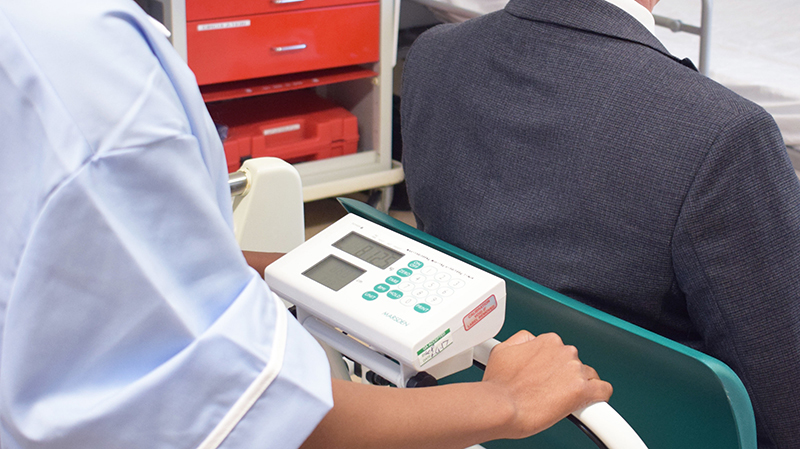Best practice: how to weigh someone who can’t stand

Pictured above: Marsden M-200 High Capacity Chair Scale.
Patients who are unable to stand can be weighed in a chair scale, a bed scale or by hoist.
Whether you are weighing patients in a care home, a hospital or in their own home, it is important to know how to weigh someone who can’t stand.
That is why our latest best practice blog post is designed to help you through the process.
It follows previous best practice blogs which have focused on how to weigh nappies, how to quickly and accurately calculate BMI, how to weigh someone in a bed, a wheelchair and how to use hoist scales.
Patients who are unable to stand can be weighed in a chair, a bed or by hoist. Here are the best practices of weighing someone who can’t stand.
Weighing in a wheelchair or using a chair scale
First, let’s take a look at how to weigh someone in a chair scale. The scale would need to be switched on before the patient sits on it. To do this, turn the scale on by using the ON/OFF button. Press Zero to reset the scale if a figure other than 0.0kg is displayed.
Next, the patient should be placed in the chair scale. If they are laid on a bed the wheelchair needs to be pushed close. Then apply the brakes so that the wheelchair cannot move.
If the patient is not strong enough to lift themselves into a sitting position, place one hand under the patient’s legs and the other under their back, and slowly raise them up. To make it easier when transferring the patient from the bed to the chair scale, hinged armrests can be placed in an upright position.
From a standing position, place the patient’s feet on the floor and slightly apart to help with balance. Face the patient, placing their hands on your shoulders for stability. Ensure your feet are a shoulder width apart and your knees are slightly bent. Place your arms around the patient’s back, clasp your hands together and lower the person into the chair, slowing bending your knees in the process.
Ensure that the patient has their feet positioned on the footrests and the arms on the armrests. The weight will appear on the indicator at the back of the chair.
You can also use a wheelchair scale to weigh a patient who can’t stand. A wheelchair scale is convenient in that the patient can stay in their own wheelchair; however, wheelchair scales are less portable. To begin with, you will need to remove the weight of the wheelchair from the scale’s reading using Tare. This can be done by pushing the empty wheelchair onto the scale and pressing Tare. Remove the wheelchair from the scale and a minus reading will be displayed. When the wheelchair and the patient are rolled back onto the scale, only the patient’s weight will be displayed. Alternatively, you can use Preset Tare if you already know the wheelchair weight.
For more information on how to weigh patients in a chair or wheelchair click here. For help in choosing the right chair scale for you read this helpful buyers’ guide. Since the guide was published we’ve also added the Marsden M-225 to our range, which has a Body Surface Area function, which is unique to Marsden scales. Browse our wheelchair scales on our website.
Weighing in a bed
Bed scales are ideal for patients who are bedbound and unable to move. The Marsden M-950 and Marsden M-955 are portable bed scales, consisting of four pads, a trolley and an indicator. The Marsden M-910, Marsden M-920 and the Marsden M-925 are more permanent bed weighing solutions.
To set up the M-950 or M-955, take each pad to a corner of the bed and position next to the castors. The colour-coded cables are then used to connect the scale pads to the indicator.
We recommend using Preset Tare if you already know the weight of the bed itself. To do this, switch the sale on, hold the Tare button for three seconds, and then use the numeric keypad to enter the weight of the bed. Press Tare to confirm the value.
Then, roll the patient in the bed onto the scale, ensuring all four castors are positioned on a pad. The weight of the patient only will be displayed.
The Marsden M-910, M-920 and M-925 bed scales sit on the floor of the hospital or care home. Simply switch the scale on, and slowly wheel the bed on the scale. Again use the Tare or Preset Tare function to take away the weight of the bed.
Find out more here. Browse our bed weighing scale range here.
Weighing with a hoist
With hoist scales, weight is measured by a downward force exerted onto them. The Marsden M-600 and Marsden M-605 Hoist Weight Scales fit to a hoist via the links on the scale and the hooks on the spreader bar of the hoist. The sling can then be attached to the bottom of the scale.
Turn the scale on, and press Zero if a figure other than 0.0kg is displayed. Add the sling to the hook and press Tare to remove the weight, so that only the patient’s weight will be displayed. The patient can now be placed into the sling. Use the Hold function to stabilise their weight.
For more information on how to use hoist scales, read our guide: Best practice: How to use hoist scales. To browse the range of hoist weighing scales on our website.
For more information on any of our scales and for help using them, call 01709 364296 or contact us here.